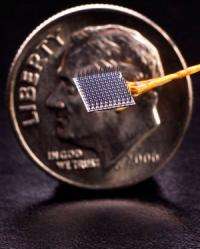Stanford joins BrainGate team developing brain-computer interface to aid people with paralysis

(Medical Xpress) -- Stanford University researchers are enrolling participants in a pioneering study investigating the feasibility of people with paralysis using a technology that interfaces directly with the brain to control computer cursors, robotic arms and other assistive devices.
Those who may be eligible to enroll in the trial include people with weakness of all four limbs resulting from cervical spinal cord injury, brainstem stroke, muscular dystrophy, or motor neuron disease, such as amyotrophic lateral sclerosis (Lou Gehrig’s disease).
The pilot clinical trial, known as BrainGate2, is based on technology developed at Brown University and is led by researchers at Massachusetts General Hospital, Brown and the Providence Veterans Affairs Medical Center. The researchers have now invited the Stanford team to establish the only trial site outside of New England.
Under development since 2002, BrainGate is a combination of hardware and software that directly senses electrical signals in the brain that control movement. The device — a baby-aspirin-sized array of electrodes — is implanted in the cerebral cortex (the outer layer of the brain) and records its signals; computer algorithms then translate the signals into digital instructions that may allow people with paralysis to control external devices.
“This technology is truly extraordinary, and I’m excited to begin testing it,” said Jaimie Henderson, MD, lead investigator of the Stanford branch of the trial. “One of the biggest contributions that Stanford can offer is our expertise in algorithms to decode what the brain is doing and turn it into action.”
The trial as a whole is directed by Leigh Hochberg, MD, PhD, who is affiliated MGH, Brown, the Providence VAMC and Harvard Medical School.
Henderson, an associate professor of neurosurgery in Stanford’s School of Medicine, will be conducting the surgeries to implant the device and then evaluating its effects. He is working with Krishna Shenoy, PhD, associate professor of electrical engineering in the School of Engineering. Shenoy’s work focuses on understanding how the brain controls movement, and translating this knowledge to build high-performance neural prosthetic systems using sophisticated software. Henderson and Shenoy co-direct Stanford’s Neural Prosthetics Translational Laboratory.
“The BrainGate program has been a model of innovation and teamwork as it has taken the first giant steps toward turning potentially life-changing technology into a reality,” Shenoy said. “This team brings together experts from a variety of fields.”
Hochberg, a critical care neurologist and neuro-engineer, welcomed his Stanford colleagues to the team.
“We couldn’t ask for a better expansion of our collaboration,” he said. “Drs. Henderson and Shenoy are leaders in the field of neural interfaces. Our combined Brown-Harvard-MGH-Stanford-VA team of physicians, scientists and engineers is well-suited not only to explore the possibilities and address the challenges of neural interface research, but simultaneously to make the fundamental discoveries that we hope will yield even greater advances in the development of restorative neurotechnologies for people with paralysis or limb loss.”
BrainGate is based on research and technology developed in the laboratory of John Donoghue, PhD, the Henry Merritt Wriston Professor of Neuroscience and Engineering at Brown University, director of the Brown Institute for Brain Science and a senior research career scientist with the Providence VA Medical Center. Donoghue co-directs the overall BrainGate research effort with Hochberg.
In 2006, Donoghue and Hochberg led the publication of a landmark paper in Nature demonstrating that trial participants could control a computer cursor and other devices directly by neural activity. In that same issue of the journal, a team led by Shenoy demonstrated a brain-computer interface system, using the same electrode array, which set important performance benchmarks.
Earlier this year, the BrainGate2 research team published another paper in the Journal of Neural Engineering showing that the system allowed a patient to accurately control a computer cursor more than 1,000 days after it was implanted.
The BrainGate team is also engaged in research toward control of advanced prosthetic limbs and toward direct brain-based control of functional electrical stimulation devices for people with spinal cord injury, in collaboration with researchers at the Cleveland Functional Electrical Stimulation Center.
“Decades of publicly funded, fundamental neuroscience research continue to provide the building blocks for tomorrow’s breakthroughs,” Donoghue said. “Translating that knowledge toward the creation of powerful assistive technologies is the BrainGate team’s continuing goal.”
The BrainGate research is one of several efforts throughout the world aiming to develop technologies to restore function by recording signals directly from the brain and converting those signals into commands for computers and assistive devices.
The systems deployed up to this time, while impressive, require further testing and development before a person with paralysis will be able to perform the same tasks at the same speed as an able-bodied person, said Henderson. While he expects the technology to require several years of continued research before it might be widely available to patients, he has high hopes for the new collaboration.
“With the tremendous synergy between Stanford, Brown, MGH/Harvard and the VA, I am confident we can make these systems useful to people with paralysis,” Henderson said. Although the BrainGate researchers will record and report how well the technology operates, the primary purpose of this pilot study is to collect initial information about whether the device is safe to use in humans.
More information: www.braingate2.org/












